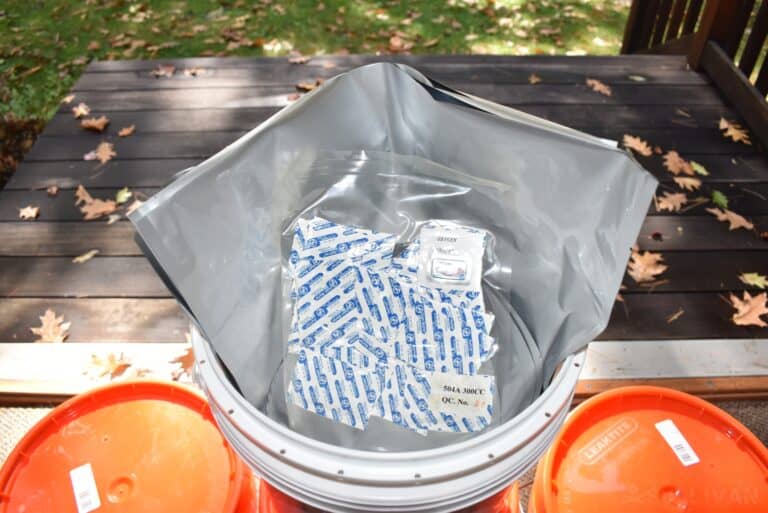Pasta is a popular staple in a preppers stash since it provides great energy at great value. The amount of volume you get with a small amount can provide for a long time if basic amenities aren’t around.

As with many dry goods, proper storage of pasta is an integral part of the preservation process.
Most will stock their shelves with airtight containers while others utilize mylar bags. Is using mylar bags a viable option for storing pasta?
Storing your pasta in mylar bags will get you up to 10 years of storage life. When compared to other methods this is one of the most effective ways to store pasta.
The basic premise will remain the same across a variety of foods.
Once you eliminate air, heat, moisture, light, and insects your food will remain shelf-stable for a long time.
Keep reading to learn more about the best ways to store pasta in mylar bags.
Why Should You Use Mylar Bags to Store Pasta?
Pasta has a tendency to go stale if it is exposed to air and dust for long periods of time.
The best way to stop this from happening is using a mylar bag as the primary storage container for pasta.
The key to successful food preservation is to eliminate all air, moisture, light, heat, and pests.
The technology found inside a mylar bag makes them airtight against anything that would spoil your food.
Heat sealing completes the cycle and you shouldn’t open your bag unless you are eating the contents within a week.
The exception is to use the resealable mylar bags where you can vacuum seal them after the initial time.
Mylar bags have several layers composed of plastics and foil, much like a mylar survival blanket
Sandwiched in the middle of the food-grade plastics is aluminum foil which blocks out light, heat, and insects.
The quality of the mylar bag does matter, so keep an eye out for high-quality products. Generally, the thicker the bag, the more protection it will offer the food.
Will Oxygen Absorbers Help?
You’ve probably seen oxygen absorbers in anything that’s dehydrated or freeze-dried.
They are little saches of iron filings that react with the oxygen in the bag and turn into rust.
As they start to rust the nitrogen given off will replace the oxygen in the bag.
The way these little sachets of iron work is not magic, but simple science. Iron oxidizes when exposed to oxygen which causes it to turn to rust.
The rust is contained so you won’t find your food covered in it. The oxygen absorbers are safe for your food and will not affect the integrity of the food.
The oxidation process releases nitrogen into the bag instead of oxygen, since the iron already absorbed it.
Nitrogen is an inert gas that does not interfere with the shelf life of the food or our health.
Remember, eliminating oxygen is key to stopping your pasta from getting stale.
What is the Storage Life of Pasta?
If you were to keep your pasta in the original packaging and store it in your cupboard or basement, you can expect to get 1-2 years out of it.
Keep in mind that this depends on a few factors, such as:
- Expiry date
- Storage method
- Environment
As you can see, mylar bags solve the problems found with conventional storage.
They maintain an optimal environment inside the bag since they are sealed and have oxygen absorbers inside.
This expands the expiry date to 10+ years and keeps your food dry and dark.
Keep in mind that a 10-year shelf life is based on optimal storage conditions outside of the bag.
If you were keeping your stored pasta in a root cellar that didn’t get exposed to moisture, it would last the full term.
But if you store it in an uninsulated basement that is prone to flooding then it would be reduced accordingly.
Optimize Your Storage Conditions
Protecting against temperature and humidity spikes are important for the quality of your stored pasta.
Here are some of the best ways to optimize your dry food storage space for pasta.
- Ensure that sunlight cannot hit the bag – Heating up the bag can cause the product inside to degrade over time.
- Keep the pasta off the ground – If your mylar bags are touching the ground then condensation can form underneath.
- Put your mylar bags in food-grade buckets – Rodents pose a problem since they can chew through the mylar bag.
Temperature is one of the most important factors when storing pasta in mylar bags.
Ensure you keep the stored pasta at room temperature or between 65-70 degrees Fahrenheit(18-21°C).
If you’re able to keep a small breeze going in the room with a fan, that ensures that the humidity doesn’t build up.
Does Pasta Expire?
The expiry date is an approximation of when your pasta will no longer be of the advertised quality. The pasta will still be edible but may lack in quality.
Important to note is the fact that the expiry date for pasta is usually a year or more from the purchase date anyway.
Storing your pasta in a mylar bag will increase that expiration date tenfold as long as you keep it in the right location.
Dried pasta is one of the most forgiving ingredients to store since it has very little moisture to begin with.
Pasta products that are made with fat or a lot of egg will have their shelf life shortened since these items tend to spoil over the long term.
Protect Against Pests and Mold
Moisture is the enemy of dried pasta as it brings the possibility of mold along with it.
Signs of mold are easy to see since they will almost alway appear as black spots on the pasta.
If you see the white fuzzy mold then that means the pasta was damp and never dried.
As with most pantry goods there is a chance that worms or other insects could get into your pasta stores.
Mylar bags prevent this with the protection of the materials used and the subsequent elimination of any odor so the insects don’t even know the pasta is there.
Pros and Cons of Storing Pasta in Mylar Bags
Storing food in mylar is the best way for you to keep your pasta as long as you can.
The main disadvantage to this method is that over time the pasta will start to lose its flavor.
Since this food is more than likely going to be used in an emergency situation, the taste and texture aren’t going to matter much as long as it is nutritionally sound.
Additionally, it can be a costly venture if you’re storing a lot of food and not cutting corners.
You need to purchase the mylar bags, the oxygen absorbers, the iron for heat sealing.
For added security you can also purchase a vacuum sealer to get rid of all the air in the package.
While it may be expensive, the final results will be worth it as your cost ratio vs calories will be low.
If you’re able to score the pasta at a lower cost with coupons or sales then the savings will be even further.
| Pros | Cons |
|---|---|
| Shelf life up to 10 years | Equipment can get expensive |
| Takes up a small amount of space | Needs electricity |
| Increased value the more that you store | Longer storage could mean the degradation of flavor |
Tips on Storing Your Pasta in Mylar Bags
Storing your pasta in mylar bags is a straightforward process but here are some tips to ensure your pasta remains fresh.
Keep track of your packaging dates – Writing the date that you sealed the mylar bag will be key in the management of your food stocks.
Rotate your pasta stock – This ensures that you don’t eat the latest expiry date before the closest one. It’s also a good chance to inspect the products for bug and rodent activity.
Be sure to plan out meals using the pasta – Regular noodles would get incredibly boring in a short period of time.
Having a stock of tomatoes, spices, and sauces to complement the stored pasta. If possible, keep all of the meal ingredients in the same food-grade bucket.
Final Thoughts
Pasta is a great source of energy in lean times when food is hard to come by.
Even if prices in the store were to rise high enough that pasta became too expensive you’ll have a large stock that is sealed against the elements for several years.
Frequently Asked Questions
These are some of the most common questions people have when storing dried pasta in mylar bags.
Yes, it is vital that the bag is sealed. The introduction of oxygen or moisture could ruin the pasta in a short amount of time.
The first thing you’ll notice is that the color of the pasta will be pale compared to when it was first stored.
This means that oxidation has taken place and the pasta will be stale. If there was oil used in making the pasta it will smell rancid as the oils have gone sour.

Perrin is an adventure guide and naturalist currently living a nomadic life in the Canadian wilderness. His education and expertise is in wilderness survival and wildlife tracking. He enjoys teaching people about the outdoors and has managed large groups on expeditions.
With several accredited certifications, including being a wilderness first responder and a leave no trace expert, Perrin believes it is important for all of us to reconnect with the natural world.
